
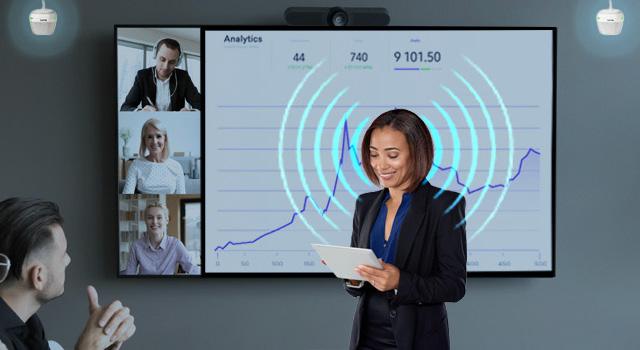
SIGNALS+ NEWSLETTER SUBSCRIPTION
Stay updated and leverage Signals+ latest insights, information and ideas on Connectivity, Digital Health, Electrification, and Smart Industry.
Thank you for subscribing to ADI Signals+. A confirmation email has been sent to your inbox.
You'll soon receive timely updates on all the breakthrough technologies impacting human lives across the globe. Enjoy!
CloseENHANCED AUDIO CONFERENCING FOR THE HYBRID WORKFORCE
Audio conferencing has become a ubiquitous way to connect workplace teams that are spread across locations and time zones worldwide. Even close to home, many employees are seeking flexibility through remote and hybrid roles, and this trend is here to stay.1
Yet conference rooms have been one of the last corners of the workplace to adapt. Installing new AV equipment can require significant time and capital outlays, and office reconfiguration can disrupt employee productivity. To avoid this, many companies continue to depend on outdated equipment, analog cables, or installations they’ve simply outgrown.
Professional audiovisual (pro AV) company Biamp teamed up with longtime partner Analog Devices, Inc. (ADI) to co-create a solution. The Parlé audio conferencing system leverages ADI’s A2B™ audio bus technology to connect multiple, distributed microphone nodes to a central processor over a single wire. With A2B, the superior quality of digital audio was only one wire away, helping Biamp resolve a connectivity bottleneck and unlock novel audio-conferencing applications.
AT A GLANCE
COMPANY
For over 45 years, Biamp has created pro AV solutions that enable great communication. From the smallest of conferencing pods to the largest of venues, Biamp aims to empower true human connection in every space.
CHALLENGE
Updating conference room technology can be costly, time-consuming, and disruptive. An ideal solution should lower the barrier to entry for companies looking to modernize their audio-conferencing experience.
GOAL
Upgrade and humanize the conference room experience for a new generation of workers, many with remote or hybrid roles, through the power of superior digital audio.
SOLUTION
ADI helped Biamp adapt the A2B audio bus solution for Parlé, bringing single-cable elegance, multichannel performance, and real-time configurability to the conference room table.
HIDDEN COSTS OF CHOOSING THE WRONG AUDIO EQUIPMENT
AV equipment has the power to connect teams and enable productivity in the modern workplace—but only when it works as intended. When it doesn’t, the costs can be significant—and this is truer of audio than video since a meeting can proceed without visuals but not without intelligible conversation.
Poor audio costs the average employee an estimated half an hour per week of time, frustration, and productivity, adding up to about 3 full workdays per year; this can cost companies tens of thousands of dollars annually.3 Poor audio can also impact reputation, potentially damaging business relationships before they even begin4—making good audio-conferencing equipment a long-term investment.
THE PARLÉ VISION
Biamp understood that a full-fledged AV upgrade isn’t always feasible. Even as better AV technology becomes more readily available, the burden of installation could still discourage companies from embracing upgrades.
That’s why Biamp envisioned an audio-conferencing solution that enables the best of both worlds: a superior, natural audio experience and reduced barrier to entry around programming, installation, and commissioning. ADI’s A2B technology helped Biamp check both of those boxes.
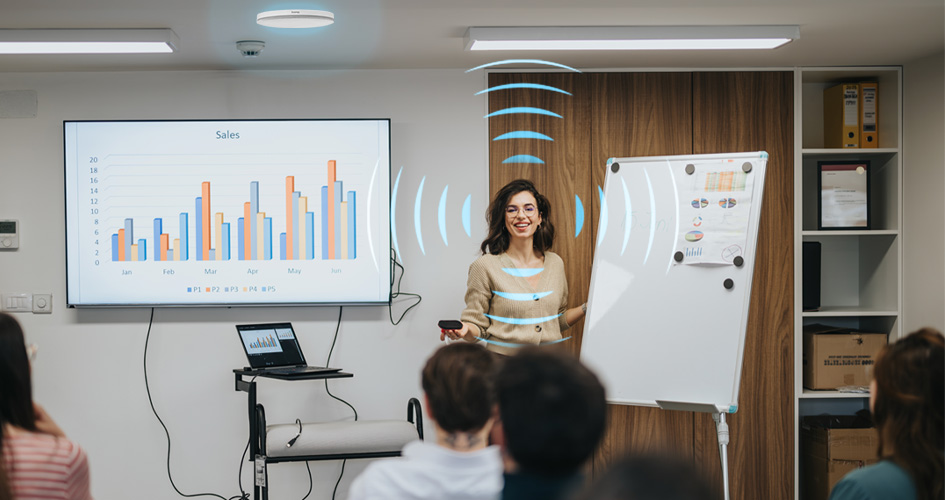
BIAMP AND ADI: WORKING IN HARMONY FOR A SOLUTION
Biamp has been using ADI’s digital signal processors (DSPs), particularly SHARC® DSP, for over a decade. However, connectivity became a bottleneck as Biamp sought to support multiple signal channels and sophisticated beamforming algorithms in its next-generation audio system. Beamforming is used to identify who is speaking and track their movement around the room.
Traditional connections, such as USB and audio over IP (AoIP), all had their limitations. ADI’s FAEs pitched A2B as a potential solution, and Biamp saw that A2B could help make their product more flexible and future-proof by enabling high-quality audio over a configurable digital interconnect.
Solutions and Considerations
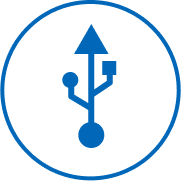
- Significant protocol maintenance software stack limits scalability.
- Limited flexibility since each additional node requires its own cabling.

- Individual software at each node makes it costly and complex to deploy and maintain.
- Requires ecosystem of compatible networks, speakers, and amplifiers.
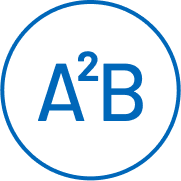
- Fully hardware synchronized
- Slim subnodes and a lean software stack support flexibility and scale.
ADI’s field applications engineers collaborated closely with Biamp, providing evaluation kits, debugging support, design insights, and a software stack to run in the main node. Leveraging known unified communications technology and tools available from ADI helped Biamp avoid the long and costly development cycles associated with building custom circuit boards.
EVOLUTION OF A2B: FROM THE CAR TO THE CONFERENCE ROOM
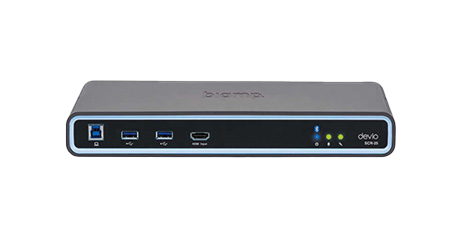
A2B uses an unshielded twisted pair (UTP) cable and daisy-chain architecture to minimize redundant cable runs, thus reducing wiring, installation challenges, and associated costs. It is best known for reducing wiring complexity and weight in automotive audio applications.
In automotive, the main advantage of A2B is providing design flexibility, scalability, and improvements in size, weight, and power by minimizing bulky cables. For Biamp, distance covered was the most important, but A2B offered many other advantages as well.
COMPARISON OF A TRADITIONAL AND A2B CONFERENCE ROOM
AUDIO INSTALLATION.5
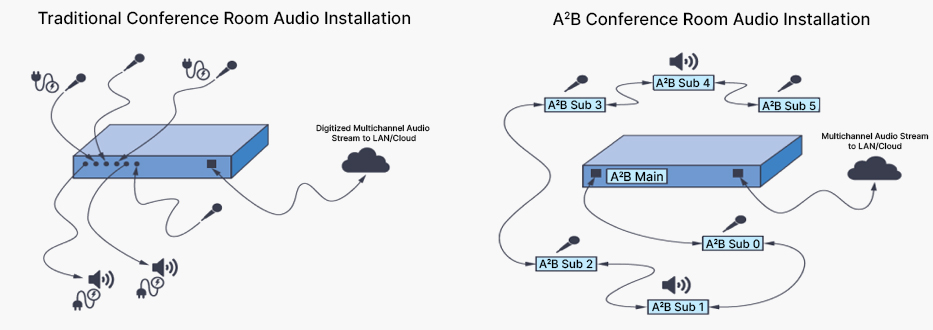
REDUCED CABLING: Parlé uses an A2B transceiver and three to four microphone nodes to service conference rooms up to 15 m. Microphone lines, command and control, power delivery, beamforming algorithms, and increased connectivity are all packed in a single, bidirectional UTP wire.
ULTRALOW DETERMINISTIC LATENCY: Audio data arrives via A2B with a known, consistent delay. A2B’s ultralow deterministic latency supports superior algorithm performance for voice processing, helping to enable Biamp’s in-house audio algorithms and ensure signal integrity.
MULTIPLE SIGNAL CHANNELS: Biamp is leveraging A2B’s 32 signal channels to enable new applications in audio-conferencing. For example, one channel can receive a signal for human intelligibility while another channel receives a signal for machine intelligibility, adding support for speech-to-text functionality.
SLIM SUB-NODES: Parlé beam tracking microphones intelligently identify the speaker and track them as they move around the conference room. A2B connects all these nodes to a single centralized processor, eliminating the need for individual DSPs to enable edge processing and local beamforming at each node.
HIGH FIDELITY: A2B supports high fidelity audio performance with optimized bus power, reducing or eliminating the need for specialty cables. In contrast, traditional cabling can limit system flexibility, inhibit performance, and invite noise interference, even over distances as short as 10 m.
FLEXIBILITY: A2B offers a robust plug-and-play stack that enables features such as hot-plugging. This ability to connect and reconfigure nodes while the system is in use can help improve serviceability since the system does not need to be shut off for troubleshooting.
ADI AND BIAMP: ENABLING THE CONFERENCE ROOM OF TOMORROW
Audio conferencing technology is more important than ever for connecting geographically diverse teams in transparent and natural ways. Co-creating with ADI helped Biamp deliver a superior, natural audio experience with its Parlé system, reducing the barrier to entry for companies looking to elevate their conferencing environment. With 32 available signal channels, A2B has much more potential to explore in audio-conferencing applications.

References
1 Nicholas Bloom, Jose Maria Barrero, Steven Davis, Brent Meyer, and Emil Mihaylov. “Survey: Remote Work Isn’t Going Away—and Executives Know It.” Harvard Business Review, August 2023.
2 “IPSOS Research (Press Release).” EPOS Group, April 2020.
3 “IPSOS Research (Press Release).” EPOS Group, April 2020.
4 “Understanding Sound Experiences (Full Report).” IPSOS on behalf of EPOS Group, 2021.
5 Carlos Martins. “Using A2B for Audio-Conferencing Systems.” Analog Devices, Inc., August 2020.




